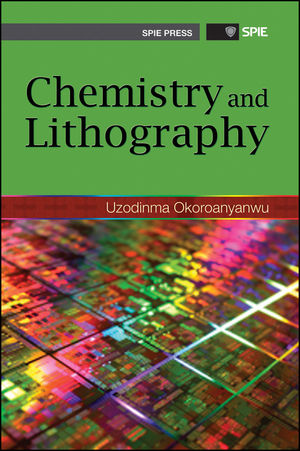Chemistry and LithographyISBN: 978-1-118-03002-8
Hardcover
892 pages
March 2011
 This is a Print-on-Demand title. It will be printed specifically to fill your order. Please allow an additional 10-15 days delivery time. The book is not returnable.
|
||||||
Acronyms and Abbreviations.
Part I. Origins, Inventions, and the Evolution of Lithography.
1. Introduction to Lithography.
2. Invention of Lithography and Photolithography.
2.1 Introduction.
2.2 Invention of Lithography.
2.3 Invention of Photolithography.
2.4 Pioneers of Photography.
3. Optical and Chemical Origins of Lithography.
3.1 Introduction.
3.2 Key Developments that Enabled the Invention and Development of Lithography.
4. Evolution and Lithography.
4.1 Introduction.
4.2 Offset Lithography.
4.3 The Printed Circuit Board and the Development of the Electronics Industry.
4.4 The Transistor and Microelectronics Revolution.
4.5 The Integrated Circuit.
4.6 Other Notable Developments in Transistor Technology.
4.7 Overall Device Technology Trends.
4.8 Semiconductor Lithography.
4.9 X-ray Lithography.
4.10 Electron-Beam Lithography.
4.11 Ion-Beam Lithography.
4.12 Extreme Ultraviolet Lithography.
4.13 Soft Lithography.
4.14 Proximal Probe Lithography.
4.15 Atom Lithography.
4.16 Stereolithography.
4.17 Molecular Self-Assembly Lithography.
Part II. Lithographic Chemicals.
5. Lithographic Chemicals.
5.1 Introduction.
5.2 Resists.
5.3 Antireflection Coatings.
5.4 Resist Developers and Rinses.
5.5 Resist Strippers and Cleaners.
5.6 Offset Lithographic Inks and Fountain Solutions.
6. Negative Resists.
6.1 Introduction.
6.2 Resins.
6.3 Types and Negative Resists.
6.4 General Considerations on the Chemistry of Cross-Linking.
6.5 Negative Resists Arising from Polymerization of Monomers.
6.6 General Considerations on the Chemistry of Photoinitiated.
6.7 General Considerations of Photoinitiated Condensation Polymerization.
6.8 General Considerations on the Photoinitiated Cationic Polymerization Employed in Negative Resist Systems.
6.9 Practical Negative Resist Compositions Arising from Photopolymerization of Monomers in the Presence of Polyfunctional Components.
6.19 Lithographic Applications of Photopolymerization Negative Resists.
7. Positive Resists.
7.1 Introduction.
7.2 Types of Positive Resists.
7.3 Resist Materials for Multilayer Resist Systems.
8. General Considerations on the Radiation and Photochemistry of Resists.
8.1 Interaction of Radiation with Resists.
8.2 Excited State Complexes.
8.3 Energy Transfer.
8.4 Energy Migration in Resist Polymers.
8.5 Spectral Sensitization.
8.6 Sensitization by Energy Transfer.
8.7 Radiation Chemistry Versus Photochemistry of Resists.
8.8 Radiation Chemical Yield and Dosimetry.
8.9 Radiation Chemistry of Polymers.
8.10 Sensitive and Exposure Radiation.
8.11 Exposure Mechanisms of Resists and Exposure Radiation.
9. Antireflection Coatings and Reflectivity Control.
9.1 Introduction.
9.2 Antireflection Coating Strategies.
9.3 Bottom Antireflection Coatings.
9.4 Applications of Bottom Antireflection Coatings.
9.5 Organic versus Inorganic Bottom Antireflection Coating and Rework/Stripping Issues.
9.6 Bottom Antireflection Coating-Resist Interactions.
9.7 Theory of Bottom Antireflection Coatings.
9.8 Bottom Antireflection Coatings for High-NA Imaging.
Part III. The Practice of Lithography.
10. Stone, Plate, and Offset Lithography.
10.1 Stone and Plate Lithography.
10.2 Offset Lithography.
10.3 The Offset Lithographic Press.
10.4 Components of an Offset Lithographic Press.
10.5 Types of Offset Lithographic Inks.
10.6 Fabrication of Lithographic Offset Plates.
10.7 The Offset Lithographic Process.
10.8 Waterless Offset Lithography.
11. The Semiconductor Lithographic Process.
11.1 Introduction.
11.2 Adhesion Promotion.
11.3 Resist Coating.
11.4 Characterizing Ultrathin Resist Processes.
11.5 Soft Bake/Prebake.
11.6 Alignment.
11.7 Exposure.
11.8 Postexposure Bake.
11.9 Monitoring Photoacid Generation in Thin Photoresist Films by Means of Fluorescence Spectroscopy.
11.10 Postexposure Bake Sensitivity.
11.11 Consequences of Acid Diffusion.
11.12 Development.
11.13 Dissolution Mechanism of Resist Polymers.
11.14 Dissolution Mechanism of Phenolic Resists.
11.15 Comparison of Dissolution Characteristics of Novolac and Poly(hydroxystyrene)-based Resists.
11.16 General Facts about the Dissolution Mechanism of DNQ/Novolac Resists.
11.17 Resist Development Issues.
11.8 Postdevelopment Bake and Resist Stabilization Treatments.
11.19 Measurement and Inspection.
11.20 Etching.
11.21 Rework/Stripping.
12. Lithographic Modeling.
12.1 Introduction.
12.2 Historical Background.
12.3 Structure of a Lithographic Model.
12.4 Basic Imaging Theory.
12.5 Accounting for Aberrations.
12.6 Aerial Image Formation Models.
12.7 Standing Wave Models.
12.8 Exposure Models.
12.9 Postexposure Bake Models.
12.10 Development Models.
12.11 Accuracy of Lithographic Models.
12.12 Applications/Uses of Lithographic Modeling.
13. Optical Lithography.
13.1 Introduction.
13.2 Elements of Optical Lithography.
13.3 UV Photochemistry in the Exposure Chamber.
13.4 Optical Materials for UV and Visible Light Lithographies.
13.5 Printing Modes.
13.6 General Considerations on Optics Relevant to Lithography.
13.7 Optical Lithographic Technologies and Their Performance.
14. X-Ray and Extreme Ultraviolet Lithographies.
14.1 Introduction.
14.2 Proximity X-Ray Lithography.
14.3 Extreme Ultraviolet Lithography.
14.4 Optics Lifetime.
14.5 Contamination Processes.
14.6 Contamination Mitigation Strategies.
16.7 EUV Resists and Imaging Performance.
15. Charged Particle Lithography.
15.1 Introduction.
15.2 Electron-Beam Lithography.
15.3 Types of Electron-Beam Lithographies.
15.4 Electron Projection Lithography.
15.5 Ion-Beam Lithography.
16. Lithography in Integrated Circuit Device Fabrication.
16.1 Introduction.
16.2 Fabrication of a 90-nm CMOS Microprocessor.
17. Advanced Resist Processing and Resist Resolution Limit Issues.
17.1 Introduction.
17.2 Resist Systems.
17.3 Advanced Resist Processing Techniques.
17.4 Resolution Limits Issues of Resists.
17.5 Resist Materials Outlook for the 22-nm and Smaller Technology Nodes.
17.6 Resist Processing Outlook for the 22-nm and Smaller Technology Nodes.
Afterword.
Index.



